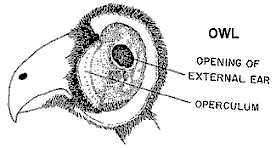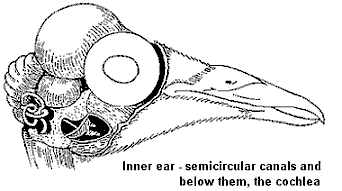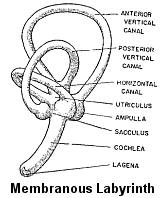The avian ear, as the mammalian ear, is an organ of hearing and balance.
 The ear is composed of three parts – an external, a middle and an inner part. The external ear lacks a flap or pinna (earlobe) and is hidden by specialized feathers known as auricular feathers. The auricular feathers protect the opening, reflect sound and enhance sound wave collection by funneling sounds toward the opening. Some species, such as owls, have asymmetrical external ears – a feature that assists these nocturnal birds when hunting.
The ear is composed of three parts – an external, a middle and an inner part. The external ear lacks a flap or pinna (earlobe) and is hidden by specialized feathers known as auricular feathers. The auricular feathers protect the opening, reflect sound and enhance sound wave collection by funneling sounds toward the opening. Some species, such as owls, have asymmetrical external ears – a feature that assists these nocturnal birds when hunting.
The external ear, or acustic meatus, is a tube that carries sound waves from the surrounding air inwards towards the ear drum. The external ear terminates as a partition known as the tympanic membrane or ear drum. This membrane separates the external ear from the middle ear.
 The middle ear is an air filled tympanic cavity containing a muscle, ligaments, the tympanic membrane, the cochlear (round) window (accessory tympanic membrane) and a rod-like bone (ossicle) known as the columella. The columella picks up sound vibrations from the eardrum and transmits them to a membranous oval window in the inner ear. Birds differ from mammals in that they have only one bony ossicle (the columella) while mammals have three.
The middle ear is an air filled tympanic cavity containing a muscle, ligaments, the tympanic membrane, the cochlear (round) window (accessory tympanic membrane) and a rod-like bone (ossicle) known as the columella. The columella picks up sound vibrations from the eardrum and transmits them to a membranous oval window in the inner ear. Birds differ from mammals in that they have only one bony ossicle (the columella) while mammals have three.
The columella extends medially across the tympanic cavity, forming a connection between the tympanic membrane and the fluid within the inner ear. The middle ear communicates with the pharynx by auditory tubes known as pharyngo tympanic tubes (analagous to our eustacian tubes) and communicates with a large group of air cavities that occupy the surrounding skull bones and extend into the mandible.
The inner ear is a complex structure of bulbs and tubes and is known as the membranous labyrinth.
The membranous labyrinth is the sensory portion of the inner ear and includes several nonauditory receptive areas composing the vestibular labyrinth and a single organ of hearing, the cochlear labyrinth. The vestibular labyrinth possesses mechanoreceptors that provide information to the brain about position and movement of the head as well as initiating reflexes involving muscles of the eyes, neck, trunk and limbs.
 The membranous labyrinth contains a viscous fluid, endolymph, and is encased by a bony labyrinth. It is separated from the bony labyrinth by a plasma-like fluid, the perilymph.
The membranous labyrinth contains a viscous fluid, endolymph, and is encased by a bony labyrinth. It is separated from the bony labyrinth by a plasma-like fluid, the perilymph.
The membranous labyrinth contains two chambers, the utriculus and the sacculus. Arching out from the utriculus are three semicircular canals- the anterior, the posterior, and the external or horizontal canal. Each canal swells into a bulbous ampulla. An endolymph-filled cochlear duct, the organ of hearing, projects downward from the sacculus.
The inner ear is the sensory receptor for both equilibrium and sound.
The Avian Ear Part II will address – how birds hear and medical problems of the ear.

